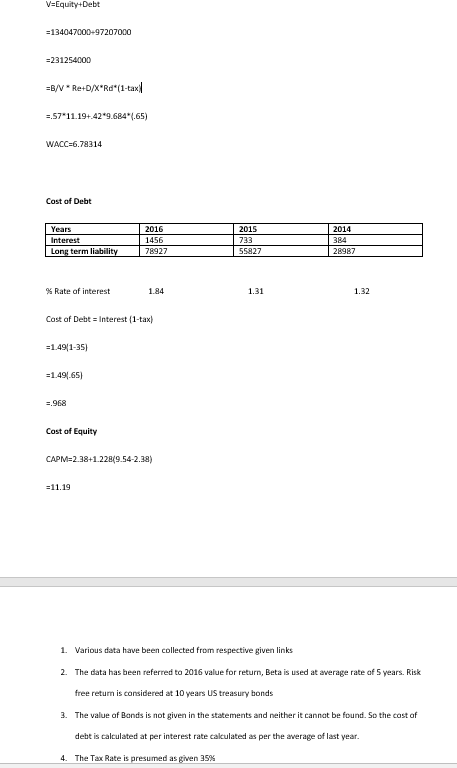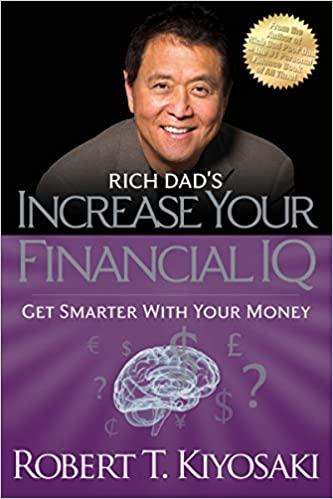The firm is looking to expand its operations by 10% of the firms net property, plant, and equipment. (Calculate this amount by taking 10% of the property, plant, and equipment figure that appears on the firms balance sheet.)The estimated life of this new property, plant, and equipment will be 12 years. The salvage value of the equipment will be 5% of the property, plant and equipments cost .The annual EBIT for this new project will be 18% of the projects cost.The company will use the straight-line method to depreciate this equipment. Also assume that there will be no increases in net working capital each year. Use the same marginal tax rate that you used in the Week 6 project.The hurdle rate for this project will be the WACC that you calculated in Week 6. The WACC was calculated as 6.7%
Income Statement:
All numbers in thousands
| Revenue | 9/30/2017 | 9/24/2016 | 9/26/2015 |
| Total Revenue | 229,234,000 | 215,639,000 | 233,715,000 |
| Cost of Revenue | 141,048,000 | 131,376,000 | 140,089,000 |
| Gross Profit | 88,186,000 | 84,263,000 | 93,626,000 |
| Operating Expenses |
| Research Development | 11,581,000 | 10,045,000 | 8,067,000 |
| Selling General and Administrative | 15,261,000 | 14,194,000 | 14,329,000 |
| Non Recurring | - | - | - |
| Others | - | - | - |
| Total Operating Expenses | - | - | - |
| Operating Income or Loss | 61,344,000 | 60,024,000 | 71,230,000 |
| Income from Continuing Operations |
| Total Other Income/Expenses Net | 2,745,000 | 1,348,000 | 1,285,000 |
| Earnings Before Interest and Taxes | 64,089,000 | 61,372,000 | 72,515,000 |
| Interest Expense | - | - | - |
| Income Before Tax | 64,089,000 | 61,372,000 | 72,515,000 |
| Income Tax Expense | 15,738,000 | 15,685,000 | 19,121,000 |
| Minority Interest | - | - | - |
| Net Income From Continuing Ops | 48,351,000 | 45,687,000 | 53,394,000 |
| Non-recurring Events |
| Discontinued Operations | - | - | - |
| Extraordinary Items | - | - | - |
| Effect Of Accounting Changes | - | - | - |
| Other Items | - | - | - |
| Net Income |
| Net Income | 48,351,000 | 45,687,000 | 53,394,000 |
| Preferred Stock And Other Adjustments | - | - | - |
| Net Income Applicable To Common Shares | 48,351,000 | 45,687,000 | 53,394,000 |
Balance Sheet:
All numbers in thousands
| Period Ending | 9/30/2017 | 9/24/2016 | 9/26/2015 |
| Current Assets |
| Cash And Cash Equivalents | 20,289,000 | 20,484,000 | 21,120,000 |
| Short Term Investments | 53,892,000 | 46,671,000 | 20,481,000 |
| Net Receivables | 35,673,000 | 29,299,000 | 30,343,000 |
| Inventory | 4,855,000 | 2,132,000 | 2,349,000 |
| Other Current Assets | 13,936,000 | 8,283,000 | 15,085,000 |
| Total Current Assets | 128,645,000 | 106,869,000 | 89,378,000 |
| Long Term Investments | 194,714,000 | 170,430,000 | 164,065,000 |
| Property Plant and Equipment | 33,783,000 | 27,010,000 | 22,471,000 |
| Goodwill | 5,717,000 | 5,414,000 | 5,116,000 |
| Intangible Assets | 2,298,000 | 3,206,000 | 3,893,000 |
| Accumulated Amortization | - | - | - |
| Other Assets | 10,162,000 | 8,757,000 | 5,422,000 |
| Deferred Long Term Asset Charges | - | - | - |
| Total Assets | 375,319,000 | 321,686,000 | 290,345,000 |
| Current Liabilities |
| Accounts Payable | 74,793,000 | 59,321,000 | 60,671,000 |
| Short/Current Long Term Debt | 18,473,000 | 11,605,000 | 10,999,000 |
| Other Current Liabilities | 7,548,000 | 8,080,000 | 8,940,000 |
| Total Current Liabilities | 100,814,000 | 79,006,000 | 80,610,000 |
| Long Term Debt | 97,207,000 | 75,427,000 | 53,329,000 |
| Other Liabilities | 40,415,000 | 36,074,000 | 33,427,000 |
| Deferred Long Term Liability Charges | 2,836,000 | 2,930,000 | 3,624,000 |
| Minority Interest | - | - | - |
| Negative Goodwill | - | - | - |
| Total Liabilities | 241,272,000 | 193,437,000 | 170,990,000 |
| Stockholders' Equity |
| Misc. Stocks Options Warrants | - | - | - |
| Redeemable Preferred Stock | - | - | - |
| Preferred Stock | - | - | - |
| Common Stock | 35,867,000 | 31,251,000 | 27,416,000 |
| Retained Earnings | 98,330,000 | 96,364,000 | 92,284,000 |
| Treasury Stock | - | - | - |
| Capital Surplus | - | - | - |
| Other Stockholder Equity | -150,000 | 634,000 | -345,000 |
| Total Stockholder Equity | 134,047,000 | 128,249,000 | 119,355,000 |
| Net Tangible Assets | 126,032,000 | 119,629,000 | 110,346,000 |
Week 6:

Week 6 solution:

roject-Calculating the Weighted Average Cost o Capital Once again, your team is the key financial management team for your company. The company's CEO is now looking to expand its operations by investing in new property, plant, and equipment. In order to effectively evaluate the project's effectiveness, you have been asked to determine the firm's weighted average cost of capital. To determine the cost of capital, here is what you have been asked to do. 1. Go to Yahoo Finance for the company you selected. (Be sure that your company has debt on their balance sheet. This will be required in your project.) om) and capture the income statement information Enter your company's name or ticker symbol. Your company's information should appear Click on the Financials tab, and select the income statement option. Three years' worth of income statements should appear. Copy and paste this data into a spreadsheet. Repeat step b. above for the balance sheets of the company Click on "Historical Prices." Capture the closing price of the stock as of the balance sheet date for the three fiscal years used in steps b and c above. a. b. C. d. 2. Calculate the Weighted Average Cost of Capital (WACC) for the company: a. Cost of Debt i. Determine the market value of the firm's debt issues. Be sure to review the firm's 10-K. Also, the website http://finra- rkets.morningstar.com/BondCenter may be of assistance. You will need to calculate the firm's composite YTM on its bonds. This can be achieved by calculating a weighted-average YTM for its bond issues. After calculating the YTM for the bond issues, calculate the firm's after-tax cost of debt. If the firm's marginal tax rate cannot be identified in its 10-K, assume that the tax rate will be 35%. ii. iii. b. Cost of Equity i. Calculate the firm's cost of equity using the capital asset pricing model (CAPM) The formula for the CAPM is r-x (Re ii. Assume the risk-free rate (r) is the current rate of 10-year U.S. Treasury Bonds. iii. Calculate the market rateRby calculating the market return on the Standard & Poor's 500 for the past 2 calendar years. The beta for the firm can be obtained from Yahoo! Finance. iv. c. Calculate the WACC Determine the market capitalization of the firm's common equity and preferred equity, if any Determine the firm's capital structure based on the market value of the firm's equity and debt. The market value of the firm's debt can be obtained from the Morningstar website, listed in the Cost of Debt section above. Calculate the WACC. As you recall, the formula for WACC is rwAcc +D+(E + D) ro(1-Tc). i. ii. iii. E (E+ D) roject-Calculating the Weighted Average Cost o Capital Once again, your team is the key financial management team for your company. The company's CEO is now looking to expand its operations by investing in new property, plant, and equipment. In order to effectively evaluate the project's effectiveness, you have been asked to determine the firm's weighted average cost of capital. To determine the cost of capital, here is what you have been asked to do. 1. Go to Yahoo Finance for the company you selected. (Be sure that your company has debt on their balance sheet. This will be required in your project.) om) and capture the income statement information Enter your company's name or ticker symbol. Your company's information should appear Click on the Financials tab, and select the income statement option. Three years' worth of income statements should appear. Copy and paste this data into a spreadsheet. Repeat step b. above for the balance sheets of the company Click on "Historical Prices." Capture the closing price of the stock as of the balance sheet date for the three fiscal years used in steps b and c above. a. b. C. d. 2. Calculate the Weighted Average Cost of Capital (WACC) for the company: a. Cost of Debt i. Determine the market value of the firm's debt issues. Be sure to review the firm's 10-K. Also, the website http://finra- rkets.morningstar.com/BondCenter may be of assistance. You will need to calculate the firm's composite YTM on its bonds. This can be achieved by calculating a weighted-average YTM for its bond issues. After calculating the YTM for the bond issues, calculate the firm's after-tax cost of debt. If the firm's marginal tax rate cannot be identified in its 10-K, assume that the tax rate will be 35%. ii. iii. b. Cost of Equity i. Calculate the firm's cost of equity using the capital asset pricing model (CAPM) The formula for the CAPM is r-x (Re ii. Assume the risk-free rate (r) is the current rate of 10-year U.S. Treasury Bonds. iii. Calculate the market rateRby calculating the market return on the Standard & Poor's 500 for the past 2 calendar years. The beta for the firm can be obtained from Yahoo! Finance. iv. c. Calculate the WACC Determine the market capitalization of the firm's common equity and preferred equity, if any Determine the firm's capital structure based on the market value of the firm's equity and debt. The market value of the firm's debt can be obtained from the Morningstar website, listed in the Cost of Debt section above. Calculate the WACC. As you recall, the formula for WACC is rwAcc +D+(E + D) ro(1-Tc). i. ii. iii. E (E+ D)








